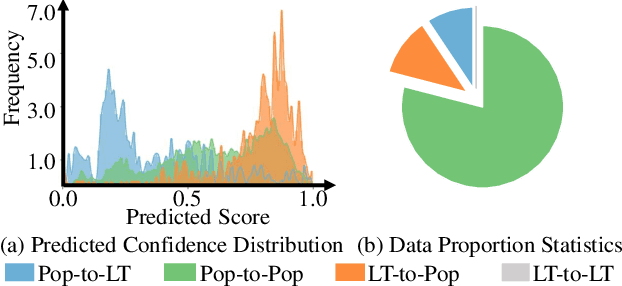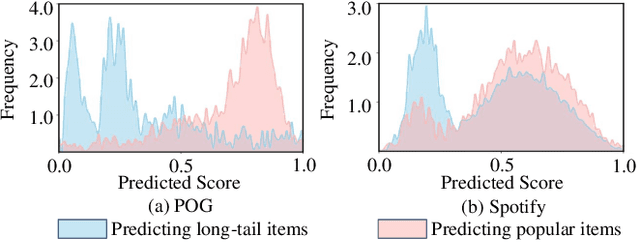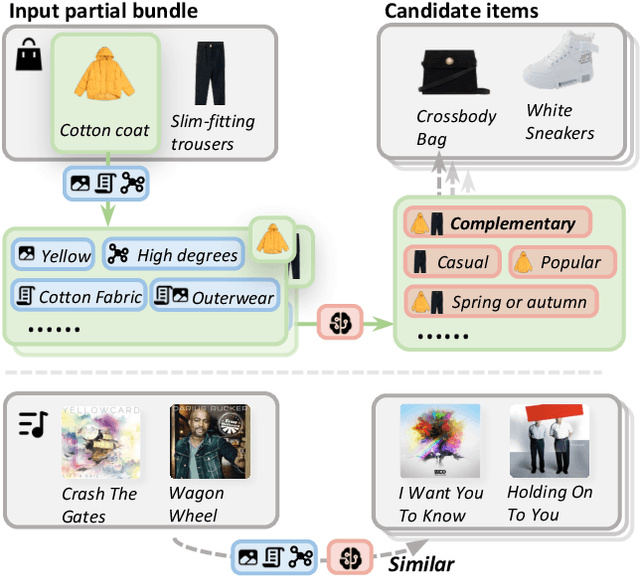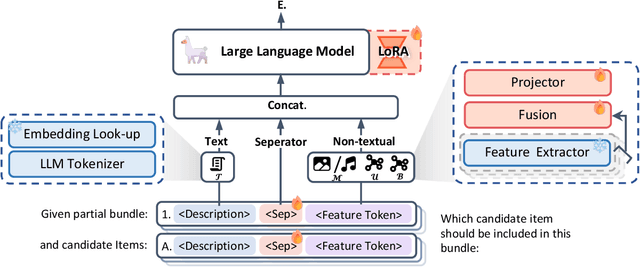Xiaohao Liu
AUV-Fusion: Cross-Modal Adversarial Fusion of User Interactions and Visual Perturbations Against VARS
Jul 30, 2025Abstract:Modern Visual-Aware Recommender Systems (VARS) exploit the integration of user interaction data and visual features to deliver personalized recommendations with high precision. However, their robustness against adversarial attacks remains largely underexplored, posing significant risks to system reliability and security. Existing attack strategies suffer from notable limitations: shilling attacks are costly and detectable, and visual-only perturbations often fail to align with user preferences. To address these challenges, we propose AUV-Fusion, a cross-modal adversarial attack framework that adopts high-order user preference modeling and cross-modal adversary generation. Specifically, we obtain robust user embeddings through multi-hop user-item interactions and transform them via an MLP into semantically aligned perturbations. These perturbations are injected onto the latent space of a pre-trained VAE within the diffusion model. By synergistically integrating genuine user interaction data with visually plausible perturbations, AUV-Fusion eliminates the need for injecting fake user profiles and effectively mitigates the challenge of insufficient user preference extraction inherent in traditional visual-only attacks. Comprehensive evaluations on diverse VARS architectures and real-world datasets demonstrate that AUV-Fusion significantly enhances the exposure of target (cold-start) items compared to conventional baseline methods. Moreover, AUV-Fusion maintains exceptional stealth under rigorous scrutiny.
Principled Multimodal Representation Learning
Jul 23, 2025Abstract:Multimodal representation learning seeks to create a unified representation space by integrating diverse data modalities to improve multimodal understanding. Traditional methods often depend on pairwise contrastive learning, which relies on a predefined anchor modality, restricting alignment across all modalities. Recent advances have investigated the simultaneous alignment of multiple modalities, yet several challenges remain, such as limitations imposed by fixed anchor points and instability arising from optimizing the product of singular values. To address the challenges, in this paper, we propose Principled Multimodal Representation Learning (PMRL), a novel framework that achieves simultaneous alignment of multiple modalities without anchor dependency in a more stable manner. Specifically, grounded in the theoretical insight that full alignment corresponds to a rank-1 Gram matrix, PMRL optimizes the dominant singular value of the representation matrix to align modalities along a shared leading direction. We propose a softmax-based loss function that treats singular values as logits to prioritize the largest singular value. Besides, instance-wise contrastive regularization on the leading eigenvectors maintains inter-instance separability and prevents representation collapse. Extensive experiments across diverse tasks demonstrate PMRL's superiority compared to baseline methods. The source code will be publicly available.
AlphaSteer: Learning Refusal Steering with Principled Null-Space Constraint
Jun 08, 2025Abstract:As LLMs are increasingly deployed in real-world applications, ensuring their ability to refuse malicious prompts, especially jailbreak attacks, is essential for safe and reliable use. Recently, activation steering has emerged as an effective approach for enhancing LLM safety by adding a refusal direction vector to internal activations of LLMs during inference, which will further induce the refusal behaviors of LLMs. However, indiscriminately applying activation steering fundamentally suffers from the trade-off between safety and utility, since the same steering vector can also lead to over-refusal and degraded performance on benign prompts. Although prior efforts, such as vector calibration and conditional steering, have attempted to mitigate this trade-off, their lack of theoretical grounding limits their robustness and effectiveness. To better address the trade-off between safety and utility, we present a theoretically grounded and empirically effective activation steering method called AlphaSteer. Specifically, it considers activation steering as a learnable process with two principled learning objectives: utility preservation and safety enhancement. For utility preservation, it learns to construct a nearly zero vector for steering benign data, with the null-space constraints. For safety enhancement, it learns to construct a refusal direction vector for steering malicious data, with the help of linear regression. Experiments across multiple jailbreak attacks and utility benchmarks demonstrate the effectiveness of AlphaSteer, which significantly improves the safety of LLMs without compromising general capabilities. Our codes are available at https://github.com/AlphaLab-USTC/AlphaSteer.
L-MTP: Leap Multi-Token Prediction Beyond Adjacent Context for Large Language Models
May 23, 2025Abstract:Large language models (LLMs) have achieved notable progress. Despite their success, next-token prediction (NTP), the dominant method for LLM training and inference, is constrained in both contextual coverage and inference efficiency due to its inherently sequential process. To overcome these challenges, we propose leap multi-token prediction~(L-MTP), an innovative token prediction method that extends the capabilities of multi-token prediction (MTP) by introducing a leap-based mechanism. Unlike conventional MTP, which generates multiple tokens at adjacent positions, L-MTP strategically skips over intermediate tokens, predicting non-sequential ones in a single forward pass. This structured leap not only enhances the model's ability to capture long-range dependencies but also enables a decoding strategy specially optimized for non-sequential leap token generation, effectively accelerating inference. We theoretically demonstrate the benefit of L-MTP in improving inference efficiency. Experiments across diverse benchmarks validate its merit in boosting both LLM performance and inference speed. The source code will be publicly available.
Extending Visual Dynamics for Video-to-Music Generation
Apr 10, 2025Abstract:Music profoundly enhances video production by improving quality, engagement, and emotional resonance, sparking growing interest in video-to-music generation. Despite recent advances, existing approaches remain limited in specific scenarios or undervalue the visual dynamics. To address these limitations, we focus on tackling the complexity of dynamics and resolving temporal misalignment between video and music representations. To this end, we propose DyViM, a novel framework to enhance dynamics modeling for video-to-music generation. Specifically, we extract frame-wise dynamics features via a simplified motion encoder inherited from optical flow methods, followed by a self-attention module for aggregation within frames. These dynamic features are then incorporated to extend existing music tokens for temporal alignment. Additionally, high-level semantics are conveyed through a cross-attention mechanism, and an annealing tuning strategy benefits to fine-tune well-trained music decoders efficiently, therefore facilitating seamless adaptation. Extensive experiments demonstrate DyViM's superiority over state-of-the-art (SOTA) methods.
Continual Multimodal Contrastive Learning
Mar 19, 2025Abstract:Multimodal contrastive learning (MCL) advances in aligning different modalities and generating multimodal representations in a joint space. By leveraging contrastive learning across diverse modalities, large-scale multimodal data enhances representational quality. However, a critical yet often overlooked challenge remains: multimodal data is rarely collected in a single process, and training from scratch is computationally expensive. Instead, emergent multimodal data can be used to optimize existing models gradually, \textit{i.e.}, models are trained on a sequence of modality pair data. We define this problem as Continual Multimodal Contrastive Learning (CMCL), an underexplored yet crucial research direction at the intersection of multimodal and continual learning. In this paper, we formulate CMCL through two specialized principles of stability and plasticity. We theoretically derive a novel optimization-based method, which projects updated gradients from dual sides onto subspaces where any gradient is prevented from interfering with the previously learned knowledge. Two upper bounds provide theoretical insights on both stability and plasticity in our solution. Beyond our theoretical contributions, we conduct experiments on multiple datasets by comparing our method against advanced continual learning baselines. The empirical results further support our claims and demonstrate the efficacy of our method. The code will be publicly available.
Towards Modality Generalization: A Benchmark and Prospective Analysis
Dec 24, 2024



Abstract:Multi-modal learning has achieved remarkable success by integrating information from various modalities, achieving superior performance in tasks like recognition and retrieval compared to uni-modal approaches. However, real-world scenarios often present novel modalities that are unseen during training due to resource and privacy constraints, a challenge current methods struggle to address. This paper introduces Modality Generalization (MG), which focuses on enabling models to generalize to unseen modalities. We define two cases: weak MG, where both seen and unseen modalities can be mapped into a joint embedding space via existing perceptors, and strong MG, where no such mappings exist. To facilitate progress, we propose a comprehensive benchmark featuring multi-modal algorithms and adapt existing methods that focus on generalization. Extensive experiments highlight the complexity of MG, exposing the limitations of existing methods and identifying key directions for future research. Our work provides a foundation for advancing robust and adaptable multi-modal models, enabling them to handle unseen modalities in realistic scenarios.
Headache to Overstock? Promoting Long-tail Items through Debiased Product Bundling
Nov 28, 2024



Abstract:Product bundling aims to organize a set of thematically related items into a combined bundle for shipment facilitation and item promotion. To increase the exposure of fresh or overstocked products, sellers typically bundle these items with popular products for inventory clearance. This specific task can be formulated as a long-tail product bundling scenario, which leverages the user-item interactions to define the popularity of each item. The inherent popularity bias in the pre-extracted user feedback features and the insufficient utilization of other popularity-independent knowledge may force the conventional bundling methods to find more popular items, thereby struggling with this long-tail bundling scenario. Through intuitive and empirical analysis, we navigate the core solution for this challenge, which is maximally mining the popularity-free features and effectively incorporating them into the bundling process. To achieve this, we propose a Distilled Modality-Oriented Knowledge Transfer framework (DieT) to effectively counter the popularity bias misintroduced by the user feedback features and adhere to the original intent behind the real-world bundling behaviors. Specifically, DieT first proposes the Popularity-free Collaborative Distribution Modeling module (PCD) to capture the popularity-independent information from the bundle-item view, which is proven most effective in the long-tail bundling scenario to enable the directional information transfer. With the tailored Unbiased Bundle-aware Knowledge Transferring module (UBT), DieT can highlight the significance of popularity-free features while mitigating the negative effects of user feedback features in the long-tail scenario via the knowledge distillation paradigm. Extensive experiments on two real-world datasets demonstrate the superiority of DieT over a list of SOTA methods in the long-tail bundling scenario.
Harnessing Large Language Models for Multimodal Product Bundling
Jul 16, 2024



Abstract:Product bundling provides clients with a strategic combination of individual items.And it has gained significant attention in recent years as a fundamental prerequisite for online services. Recent methods utilize multimodal information through sophisticated extractors for bundling, but remain limited by inferior semantic understanding, the restricted scope of knowledge, and an inability to handle cold-start issues.Despite the extensive knowledge and complex reasoning capabilities of large language models (LLMs), their direct utilization fails to process multimodalities and exploit their knowledge for multimodal product bundling. Adapting LLMs for this purpose involves demonstrating the synergies among different modalities and designing an effective optimization strategy for bundling, which remains challenging.To this end, we introduce Bundle-LLM to bridge the gap between LLMs and product bundling tasks. Sepcifically, we utilize a hybrid item tokenization to integrate multimodal information, where a simple yet powerful multimodal fusion module followed by a trainable projector embeds all non-textual features into a single token. This module not only explicitly exhibits the interplays among modalities but also shortens the prompt length, thereby boosting efficiency.By designing a prompt template, we formulate product bundling as a multiple-choice question given candidate items. Furthermore, we adopt progressive optimization strategy to fine-tune the LLMs for disentangled objectives, achieving effective product bundling capability with comprehensive multimodal semantic understanding.Extensive experiments on four datasets from two application domains show that our approach outperforms a range of state-of-the-art (SOTA) methods.
LARP: Language Audio Relational Pre-training for Cold-Start Playlist Continuation
Jun 20, 2024Abstract:As online music consumption increasingly shifts towards playlist-based listening, the task of playlist continuation, in which an algorithm suggests songs to extend a playlist in a personalized and musically cohesive manner, has become vital to the success of music streaming. Currently, many existing playlist continuation approaches rely on collaborative filtering methods to perform recommendation. However, such methods will struggle to recommend songs that lack interaction data, an issue known as the cold-start problem. Current approaches to this challenge design complex mechanisms for extracting relational signals from sparse collaborative data and integrating them into content representations. However, these approaches leave content representation learning out of scope and utilize frozen, pre-trained content models that may not be aligned with the distribution or format of a specific musical setting. Furthermore, even the musical state-of-the-art content modules are either (1) incompatible with the cold-start setting or (2) unable to effectively integrate cross-modal and relational signals. In this paper, we introduce LARP, a multi-modal cold-start playlist continuation model, to effectively overcome these limitations. LARP is a three-stage contrastive learning framework that integrates both multi-modal and relational signals into its learned representations. Our framework uses increasing stages of task-specific abstraction: within-track (language-audio) contrastive loss, track-track contrastive loss, and track-playlist contrastive loss. Experimental results on two publicly available datasets demonstrate the efficacy of LARP over uni-modal and multi-modal models for playlist continuation in a cold-start setting. Code and dataset are released at: https://github.com/Rsalganik1123/LARP.
 Add to Chrome
Add to Chrome Add to Firefox
Add to Firefox Add to Edge
Add to Edge